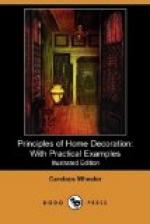Some skilful painters can stipple one tone upon another so as to produce the same brilliant softness of effect, and when this can be done, oil-colour upon plaster is the best of all treatment for bedrooms since it fulfils all the sanitary and other conditions so necessary in sleeping-rooms. The same effect may be produced if the walls are of rough instead of smooth plaster, so that the small inequalities of surface give light and shadow as in textiles; upon such surfaces a pleasant tint in flat colour is always good. Painted burlaps and certain Japanese papers prepared with what may be called a textile or canvas surface give the same effect, and indeed quality of tint and tone is far more easily obtained in wall-coverings or applied materials than in paint, because in most wall-coverings there are variations of tint produced in the very substance of the material.
This matter of variation without contrast in wall-surface, is one of the most important in house decoration, and has led to the increased use of textiles in houses where artistic effects have been carefully studied and are considered of importance.
Of course wall-paper must continue to be the chief means of wall-covering, on account of its cheapness, and because it is the readiest means of sheathing a plaster surface; and a continuous demand for papers of good and nearly uniform colour, and the sort of inconspicuous design which fits them for modest interiors will have the effect of increasing the manufacture of desirable and artistic things.
In the meantime one should carefully avoid the violently coloured papers which are made only to sell; materials which catch the eye of the inexperienced and tempt them into the buying of things which are productive of lasting unrest. It is in the nature of positive masses and strongly contrasting colours to produce this effect.
If one is unfortunate enough to occupy a room of which the walls are covered with one of these glaring designs, and circumstances prevent a radical change, the simplest expedient is to cover the whole surface with a kalsomine or chalk-wash, of some agreeable tint. This will dry in an hour or two and present a nearly uniform surface, in which the printed design of the paper, if it appears at all, will be a mere suggestion. Papers where the design is carried in colour only a few shades darker than the background, are also safe, and—if the design is a good one—often very desirable for halls and dining-rooms. In skilfully printed papers of the sort the design often has the effect of a mere shadow-play of form.
Of course in the infinite varieties of use and the numberless variations of personal taste, there are, and should be, innumerable differences in application of both colour and materials to interiors. There are differences in the use of rooms which may make a sense of perfect seclusion desirable, as, for instance, in libraries, or rooms used exclusively for evening gatherings of the family. In such semi-private rooms the treatment should give a sense of close family life rather than space, while in drawing-rooms it should be exactly the reverse, and this effect is easily secured by competent use of colour.




